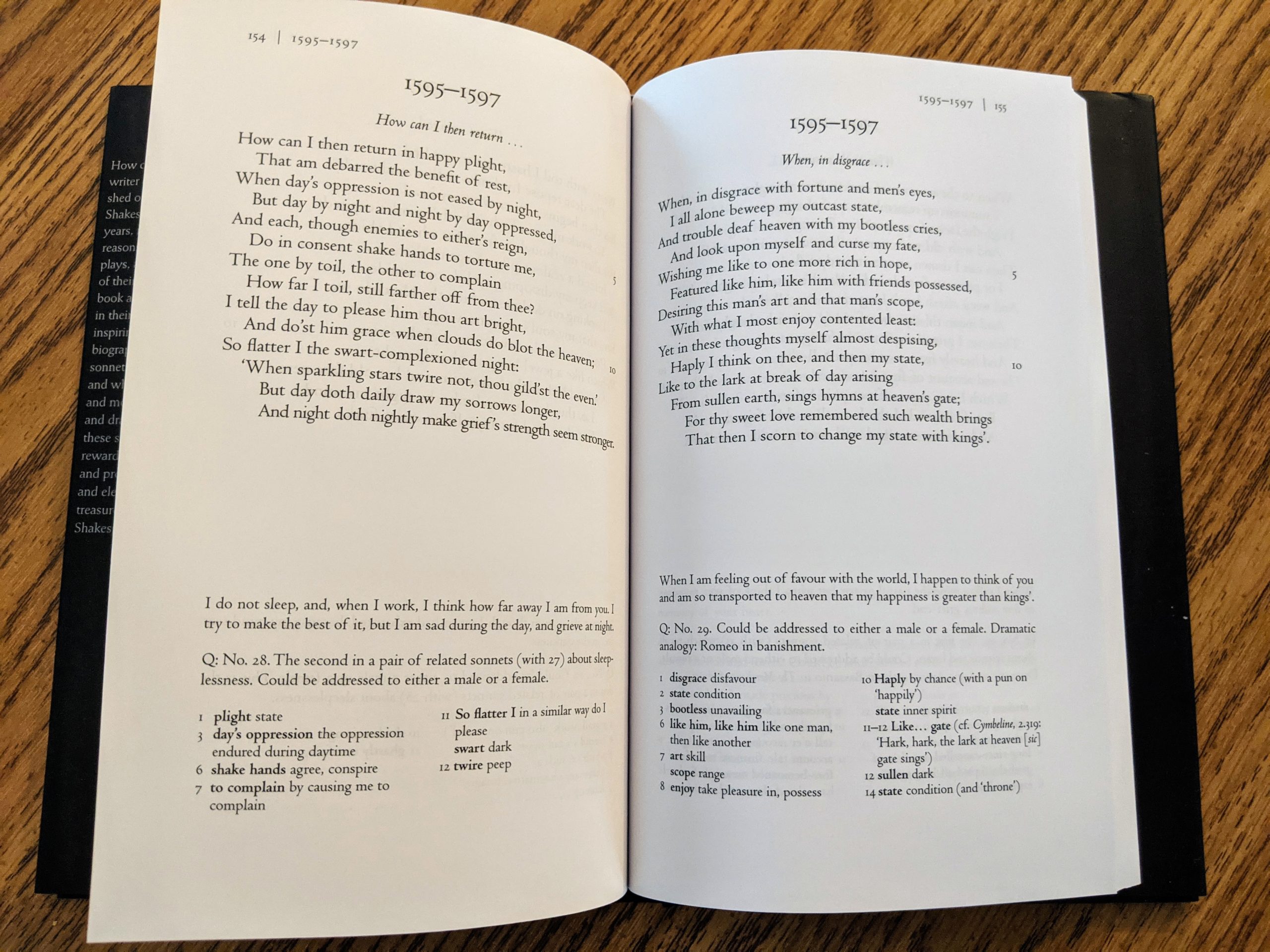Having only a casual understanding of Shakespeare’s sonnets, I admit to being intimidated by All the Sonnets of Shakespeare, edited by Paul Edmondson and Stanley Wells (with a quote from Judi Dench on the cover, just to name drop some more 🙂 ). I already own a handful of copies of the sonnets, but most different only in design. This one is a different beast – a complete reorganization of all the sonnets (including those in the plays, not just the most well known 154). I read some early reviews where people were already arguing about some of the choices made. I don’t have the academic credentials to say much on that level.

But I figured, that’s never stopped me before, and I can certainly tackle it from the only perspective I know, that of a casual reader, interested in learning more about the topic. It’s worked for me thus far.
The layout of the individual sonnet pages is very nice and already informative. Ordered by likely date they were written, each sonnet is presented along with a simple glossary of terms, as well as a simple summary of the sonnet’s theme (“You look beautiful and your name has a good reputation, which you use powerfully to hide your misdemeanors, but it is a power you should use with caution.”). I’m thinking those summaries alone might make a fun game, see if you can guess which sonnet goes with which summary.
Then comes the numbering, and why. The “original” number is marked, though this does not reflect the order that the sonnets are presented. For an easy example I went hunting for sonnet 130 (“My mistress’ eyes are nothing like the sun…”) and found it near the front of the book in the 1590-1595 section. Some thoughts are provided on each sonnet, almost like a “What might Shakespeare have been thinking?” moment. Here, for example: “Dramatic analogy: Benedick on Beatrice in Much Ado About Nothing.” I’d never made that connection before. But it makes sense, I get it.
To give you an idea how the reordering/grouping ends up working, sonnet 130 is still followed by 131 through 137, then we break to show how 138 first showed up in The Passionate Pilgrim, side by side with the 1609 version, with notes comparing the differences. That’s kind of cool. That’s the bite-sized kind of new information I like processing. “Unskilful in the world’s false forgeries” versus “Unlearned in the world’s false subtleties.” Did Shakespeare change it, or was one of them just a corrupt forgery? Papers have probably been written on the evidence for answers to that question.

The “regular” grouping of this set of sonnets continues up to #152 (with another Passionate Pilgrim side track at #144). So that’s where I get curious again, where do 153 and 154 end up?
#154 actually opens the book! It’s listed in the Pre 1582 section (making Shakespeare a teenager? fascinating!), and the notes suggest that this and #153 (which is listed next) being just paraphrases of a Greek epigram could mean that Shakespeare was recalling his schoolboy exercises.
On top of all that, there’s even more to this book. After all the sonnets are laid out as above, there’s a “literal paraphrases” section that goes through each and repeats it back in mostly modern language. This feels a bit like it was added to beef up the page count. They’re not formatted, shoving three paragraph looking sonnets onto each page. I’m not really sure who these are for, as typically a student who doesn’t follow the original language (even with the included glossary) would benefit more from a side by side and line by line translation, not “flip to the back of the book for a quick blurb on each one, if you can find it.”
But wait, there’s more! There’s an index mapping each sonnet number to its page number. Wish I’d thought to look for that sooner :), I would have known that sonnet 130 shows up on page 58, and sonnet 154 is on page 47. I said the book starts with #154, and I wasn’t lying – there’s a very long introduction 🙂
Hold on! Act now and you get another index! The addition of a “first lines” index is kind of neat, perhaps for the people who can remember enough to say, “I like that one that goes In faith my friend you never can grow old, which one was that?” and you can figure out that it’s sonnet #104 on page 200. Once you remember to get the quote right. 😉
Overall, this reminded me of an academic Shakespearean “choose your own adventure” book, as you could perhaps tell from my haphazard jumping through it. I picked an effectively random spot to start, then as I got curious, I flipped around where my interest led me, whether it was to see which sonnets came next in sequence, or where a sonnet was when it wasn’t where I thought it should be. I learned some things, and I’m sure if I eventually sit with it more, I’ll learn more. The information about each sonnet is not particularly dense, there’s not several pages defending the placement of each one and adding context for how that conclusion came to be. Not nearly as intimidating as I feared.

